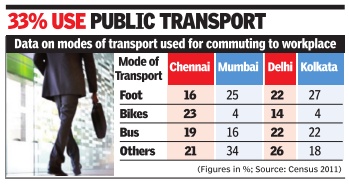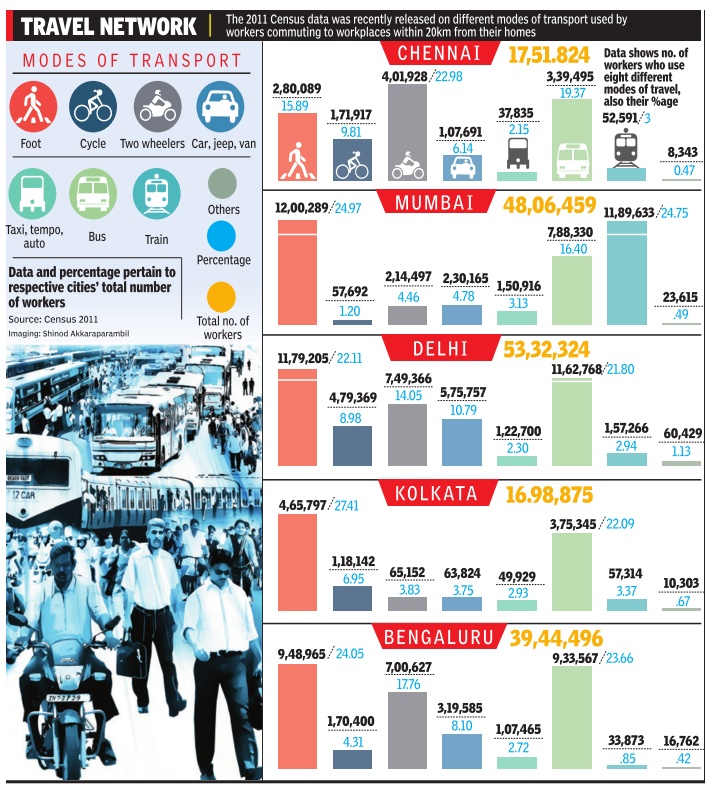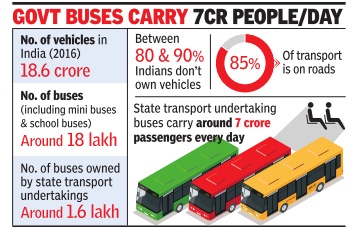Transport sector: India


This article has been sourced from an authoritative, official readers who wish to update or add further details can do so on a ‘Part II’ of this article. |
Contents |
How Indians commute to work
The Times of India, Nov 12 2015

Sivakumar B
20% walk
Long way to go: One in five Indians still walks to work
Well into the 21st century, more than one in five Indians walk to their work and less than 15% take public transportation. Some 33% use other modes of transport than buses and trains to reach their workplaces situated up to 20 km from their homes. Another 23% walk while 30% don't stir out of their houses but still work. These figures are based on recently released 2011 Census data on different modes of transport used by workers commuting to workplaces within 20km from their homes. Agricultural workers and domestic helps weren't considered in the survey . Of the nearly 20 crore workers surveyed, 4.5 crore walked to their workplace.
Most of those who work from home are in rural areas.“In urban areas, a large number of people who walk to work are poor. They often walk long distances in spite of inconvenient and dangerous conditions because they cannot afford any other form of transport,“ Institute of Transportation and Develop ment Policy regional director Shreya Gadepalli told TOI.
Experts see these figures as yet another reason for planners to take into account facilities for pedestrians.
In rural areas it is mainly lack of access to transport facilities that forces people to walk to work, Shreya said. The percentage of women who walk to work is even higher in urban areas.However, wide, continuous and shaded footpaths along with safe and frequent street-level crossings can entice higher-income people too to walk. Good footpaths also encourage the use of public transport,“ Shreya said. Only 11.4% workers in the country use buses and 3.5% of the workers have access to train, which includes Metro and MRTS in cities like Chennai. After foot and bicycle, the most preferred transport is twowheelers -more than 2.5 crore or 12.7% travel to their workplace by two-wheelers.
Of this, nearly 75% are in urban areas. Only 2.7% use car, jeep or van and 3% take an autorickshaw or a taxi.
“States must concentrate on developing better transport infrastructure in urban areas as a majority of workers are in cities and towns,“ said former Anna University urban engineering professor K P Subramanian. There should be better integration of multi-modal transport systems, he said. Urban authorities must discourage use of cars if there is proper connectivity between all modes of public transport, he aded.
Commuting by car
The Times of India, Nov 13 2015

Meera Vankipuram
Delhi, Chennai top in car usage, reveals data T he 2011 Census data has revealed that Delhi has the highest number of workers in the country who commute by car, jeep or van at 10.79%. Chennai is in second place with 6.14%, while Mumbai is in third place at 4.78%. Kolkata (2.93%) and Bengaluru (2.72%) have the least number of commuters who take cars or vans to work, among the five metros.
According to transport ministry data, Delhi has the highest number of cars compared to any other metro city in India. While the highly efficient Delhi Metro helped ease traffic on city roads, of late, the burgeoning peak hour crowd has made it difficult for many Delhiites to use the Metro. Between 8am and 11am on weekdays, for example, the trains carry nearly 1 lakh passengers.
Dilip Singh, 49, a general manager with a private firm in New Delhi, prefers to use metro. Of late though, many commuters drive their cars to work due to overcrowding of trains during peak hours.“Metro is not equipped to handle the massive morning and evening traffic,“ he said. Also, many Delhiites view cars as a status symbol, he said.
In Chennai, poor connectivity of public transport systems force many working professionals to use cars and vans. Rajiv Balaram, 26, who is employed at an IT firm in Sholinganallur felt that that it is impossible to get to his office without using a car or auto.“Many of us who work on the IT corridor are able to use the trains or buses only upto a certain point. After that, we depend on shared autos, cabs or cars,“ he said.
Kolkata, where less than 3% of workers drive to work, has a robust transport network that includes the metro, buses, taxis, trams and autos.This network spares commuters the need to use personal vehicles.
The city also has a strong local railway network that carries 35 lakh commuters a day . The Kolkata Metro, which serves all the major office localities of Kolkata carries 5 lakh passengers daily .Taxis carry around 16 lakh commuters a day and trams still carry around 6-7% of the daily commuter load.
This is why Kolkata was chosen by World Bank as the city with most sustainable transport system in India, said chief traffic and transportation engineer Anup Chatterjee.
Commuting by bus, train
The Times of India, Nov 13 2015
Ayyappan V
Buses, first choice of many
Mumbai and Delhi have the largest number of people among cities in the country who use buses and trains to commute to work, data from the 2011 Census shows. The reason is simple: both cities have a good network of buses and trains. Of the working population in Mumbai, around 41.15% of the people use buses and trains to commute to their workplaces, while in Delhi it's 24.74%. In comparison, in Chennai, 19.37% of the workers took buses, while only 3% depended on trains to reach their work place. The share of public transport in a city should ideally be 60%.
This is why the Union ministry of urban transport has been pushing for mass rapid transit systems like metro rail and monorail in fast-growing urban cen tres.
In Mumbai, trains claim a share of 24.75% of all working people, while the share of buses is 16.4%.In Delhi, however, more people use buses because the suburban network is not convenient for residents and many of them have migrated to metro rail.
A senior railway official, who was involved in urban NOT AN EASY TRIP transit system planning, said the share of public transport had increased tremendously after metro rail extended its network across the national capital region.
Indian cities have to do a lot to make their public transport sys tems usable and reliable, especially by introducing intermodal connectivity so that people can switch from one mode of transport to another with ease during their trip from doorstep to workplace.
Binoy Mascarenhas of Embarq Mumbai, said, “Mumbai has a good track record of people using public transport. Majority of the trips for work are on public transport. Trains are the most popular while buses come second in preference.Metro rail will also have a good impact in boosting public trans port over the next 20 years when its entire network is ready.“
The reason for change in volume of patronage varies from city to city-from geography to poor capacity and poor connectivity . The choice of transport system depends on the nature of the city . Mumbai's linear geography makes trains the choice while that may not be the case with cities like Bengaluru and Delhi.
Mumbai tops list of train users
Though faster and cheaper, trains are not preferred much by people to travel to work in major cities in the country.Mumbai tops the list of cities where people use the services to travel to work among Delhi, Kolkata and Chennai. Among the four cities, Mumbai and Chennai have an efficient network of suburban trains. The 2011 Census statistics showed that among the metros, Mumbai tops the list with 24.75% workers using trains to their workplaces. This means that around 11,89,633 people prefer to use the suburban services. Delhi's trains are used by 2.94% of its work ing population. This includes people using long distance trains that come into the city to travel into the national capital for work. However, the number must have changed over the past few years because the region now has a substantial metro rail network. TNN
The kinds of transport Indians use
1951-2016> #1: two-wheelers; # distant 2: cars; shortage of buses

From: Dipak Dash, India needs 30L buses for transport, has only 3 lakh, September 8, 2018: The Times of India
4 Buses Per 10K People Fuels Pvt Vehicle Spurt
The total number of buses available for transporting general passengers is less than one-tenth of the requirement, posing an enormous logistical challenge. According to government data, there are about 19 lakh buses in the country and only 2.8 lakh of them are run either by state transport undertakings or under stage carriage permits.
“We need about 30 lakh buses to meet the requirement of general passengers. The ones run by the state transport entities are also operating at sub-optimal levels. So there is a huge gap,” Union transport secretary Y S Malik said. Public transport experts said that the falling quality of service and non-availability of buses has also pushed people to own private vehicles both in urban and rural areas.
Union transport minister Nitin Gadkari said while China has about six buses for 1,000 people, India has only four buses per 10,000 people and about 90% Indians don’t own any vehicle.
‘Despite metro, people will still take buses’
They are dependent on shared mobility. So the answer lies in improving public transport. Private people should come forward for a model like Transport for London (TfL) here. I have urged manufacturers that apart from manufacturing buses you open an operator company. They will get business. If manufacturers like Tata, Ashok Leyland could invest and introduce a fleet of such buses, it can easily be run,” Gadkari said.
Experts in the urban transport sector said despite increasing penetration of Metro rail networks and cab services, a large chunk of people will use buses for commuting. In London, despite the intensity of rail network, about 62 lakh journeys out of the total 317 lakh per day are through buses, Shashi Verma, director of strategy and chief technology officer of TfL, said. Rail, underground (Metro) and light rail put together have about 74 lakh share of the total journey, Verma said.
Verma added that while the per-kilometre cost of running state transport buses in India is estimated around Rs 120-150 per kilometre, this can come down by half if private operators take up the task.
1950-2020

From: February 2, 2022: The Times of India
See graphic:
1950-2020- The kinds of transport that Indians used: road, rail and air travel
Transport
The source of this article
INDIA 2012
A REFERENCE ANNUAL
Compiled by
RESEARCH, REFERENCE AND TRAINING DIVISION
PUBLICATIONS DIVISION
MINISTRY OF INFORMATION AND BROADCASTING
GOVERNMENT OF INDIA
A well-knit and co-ordinated system of transport plays an important role in the
sustained economic growth of a country. The present transport system of the country
comprises several modes of transport including rail, road, coastal shipping, air
transport, etc. Transport has recorded a substantial growth over the years both in
spread of network and in output of the system. The Ministry of Shipping and the
Ministry of Road Transport and Highways are responsible for the formation and
implementation of policies and programmes for the development of various modes
of transport save the railways and the civil aviation.
Dipak Dash, September 3, 2018: The Times of India

i) Number of vehicles sold;
ii) Passenger trips in urban areas
From: Dipak Dash, September 3, 2018: The Times of India
India’s public transport system is not keeping pace with the auto boom, making commuters shun buses and trains and hop on to two-wheelers and cars. This has resulted in public transport’s share of passenger trips falling to an all-time low, and the situation is getting worse with every passing year.
Compared with a share of 60-80% of passenger trips across major Indian cities in 1994, the share of public transport is expected to reduce to 25-35% in 2018.
The culprit seems to be the city bus infrastructure as the number of buses has not increased during the last four years, while there has been a significant rise in the twoand four-wheeler populations, adding to the congestion on urban roads.
The last 10-15 years have seen rapid Metro construction work in cities such as Delhi, with Bengaluru, Mumbai, Jaipur and Lucknow also joining the map, although at a slower pace.
Bus fleets stay underused due to restrictive permit norms
A study by global consulting firm AT Kearney showed that the twoand four-wheeler population went up 8-10% annually between 2014 and 2017, even as the stock of registered buses recovered in 2017 after a dip.
“There is a flat/negative growth in bus fleet, modal mix is skewed towards cars and two-wheelers,” AT Kearney said in its report. Some of the urban experts TOI talked to said the sharp fall in the share of passenger trips using public transport in urban areas was not just surprising, but alarming.
“A car or a two-wheeler offers commuters the flexibility to move from their flat to their office. There are neither incentives to use public transport nor disincentives like hefty parking charges or a high registration fee for private vehicles,” a government officer said.
As a result, existing bus fleets are largely underutilised due to restrictive permit conditions and other regulations. Nearly 1.4 lakh of the19 lakh registered buses are run by state road transport undertakings, and the remaining 90% are run by private players or are attached to educational institutions and other entities.
Urban transport planner N Ranganathan, former head of transport planning at Delhi’s School of Planning and Architecture, said the government should not expect more than 20% of car owners to shift to public transport even if there was adequate availability and comfort.
Heritage Transport Museum, Gurugram/2017
Ashok Kumar, Museum restores 64-year-old steam locomotive, May 13, 2017: The Hindu

Heritage Transport Museum in Gurugram is first private institute to have a fully-functional steam locomotive
Recreating the magic of the bygone era of steam railways, the Heritage Transport Museum on Bilaspur-Tauru Road here has restored a 64-year-old steam locomotive. The museum has become the first private institute in India to have a fully-functional steam locomotive.
Built in 1953 by Arnold Jung Lokomotivfabrik, the locomotive was procured by the museum as scrap in October last year after persuading the Indian Railways (Heritage Cell).
Awe-inspiring sight
A team of engineers led by M. S. Rangaswamy worked on the locomotive for over one month. The engine finally ran on a 100-foot track, specially built on museum premises, on Saturday afternoon.
The locomotive took hours to get going and in wondrous display of power and might, let off steam when shut down.
The scene was in contrast to the modern day electric or diesel locomotives that start instantly and never make a fuss.
The extraordinary sight, sound and smell were taken in by awestruck spectators.
Around 12-feet tall and 31-feet long, the locomotive weighs over 47 tons and can carry 1,320 gallons of water and needs over four tons of coal to feed its voracious appetite. It operates on a broad gauge and its wheel configuration is 0-6-0.
Tarun Thakral, founder and managing trustee of the Heritage Transport Museum, said that the restoration reaffirmed the museum’s philosophy of providing visitors an unparalleled experience.
Costly affair
The museum has spent over ₹12 lakh in the buying and restoration of the steam locomotive.
Mr. Thakral said that the cost of starting the engine each time was around ₹10,000 and the museum was looking for some sponsors so that it could operate the train on special occasions such as Republic Day and Independence Day.
Mr. Rangaswamy, a retired senior section engineer, said that the locomotive had not been operational for over two decades, but was in a fairly good condition.
“We faced a major challenge in procuring several parts that needed to be replaced. Though not of good quality, we managed to get most of the parts at Chawri Bazar. The restoration work started in March and was completed in 34 days. The first trial run was conducted on May 7,” said Mr. Rangaswamy, who has resurrected the worlds heaviest and largest locomotive as well.
The restoration work on the museum’s other steam locomotive, a 1921 Kerr Stuart, is due to begin in winter this year.
The museum, which is home to more than 2,500 curated objects, was opened to the public in 2013 and is India’s first comprehensive transport museum.
Public transport in India
Buses, 2016
The Times of India, Aug 15 2016

Dipak Dash
Cities choked, but 90% of Indians don't own vehicle
Even as cities reel under the growing burden of private vehicles, government data shows that nearly 90% of Indians don't own a vehicle.
According to government estimates, there are 18.64 crore vehicles in the country , including two-wheelers. Of these, 18 lakh are buses, which include a large number of mini buses and buses owned by schools and other educational institutions. Worryingly , only 1.6 lakh buses are owned by state road transport undertakings (SRTUs), which serve as the main mode of mass ro ad transport across states.
Records show that the share of buses in the total number of vehicles has decreased from 10% in 1951 to only 1% now. There is hardly any indication of this changing any time soon as two-wheelers have become the preferred replacement for public transport both in urban and rural areas.
2017: international and inter-state comparisons

Vis-à-vis other countries, and
inter-state comparisons.
Presumably as in 2017
From: September 25, 2018: The Times of India
September 25, 2018: The Times of India
See graphic:
The availability of buses in India:
Vis-à-vis other countries, and
inter-state comparisons.
Presumably as in 2017